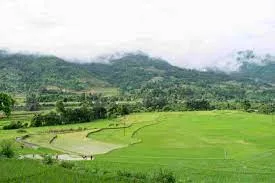The Kashmir Valley, nestled within the majestic Himalayan range, is a sanctuary of remarkable biodiversity, hosting numerous endemic plant and animal species. However, over time, this delicate ecosystem has been increasingly threatened by invasive species. These non-native organisms, whether introduced deliberately or accidentally through human activities, have disrupted the region’s ecological balance. Exotic plants and animals were often introduced intentionally to enhance agriculture or aquaculture, but these introductions have had unintended ecological consequences. Additionally, unintentional factors, such as contaminated seeds and waterborne transport, have further facilitated the spread of invasive organisms.
Ceratophyllum demersum (Hornwort), a submerged aquatic plant native to tropical and temperate regions, has rapidly proliferated in Kashmir’s lakes, including Manasbal Lake. Accidentally introduced through water transportation and aquaculture, it forms dense, single-species mats that deplete oxygen levels, alter water chemistry, and outcompete native aquatic vegetation. Similarly, Parthenium hysterophorus (Congress Grass), unintentionally introduced through contaminated grain imports, has aggressively spread across agricultural fields and wastelands. Known for causing severe allergies in humans and being toxic to livestock, Parthenium poses significant ecological and economic challenges. Another invasive species, Ageratum conyzoides (Billygoat Weed), was initially introduced as an ornamental plant but has since escaped cultivation to establish dominance in forests and agricultural areas. Its allelopathic properties inhibit the growth of native plant species, further disrupting local ecosystems.
Invasive faunal species have significantly impacted Kashmir’s delicate ecosystem, particularly with the introduction of Cyprinus carpio (Common Carp) and Sus scrofa (Wild Boar). The common carp, deliberately introduced in 1956 to boost local fisheries, has rapidly proliferated in water bodies such as Manasbal Lake. Its unchecked expansion has led to a decline in indigenous fish populations, as its feeding behavior disturbs sediments, increasing water turbidity and degrading aquatic habitats. Similarly, wild boars, though native to certain parts of India, have extended their range into Kashmir, likely due to habitat disturbances. Their presence poses severe threats to agriculture, as they damage crops and compete with native herbivores for resources, causing economic and ecological imbalances.
The introduction and spread of invasive species in Kashmir can be attributed to various human activities. Agricultural practices have played a significant role, as the import of high-yield crop varieties often carried weed seeds, unintentionally introducing invasive species into local agroecosystems. Similarly, the ornamental plant trade has contributed to the problem, with exotic plants valued for their aesthetic appeal escaping controlled environments and becoming invasive in the wild. In the realm of aquaculture and fisheries, the introduction of non-native fish species for economic benefits has led to the displacement of indigenous aquatic life, disrupting the natural balance of water ecosystems. Additionally, increasing tourism and transport have inadvertently facilitated the spread of invasive seeds, pathogens, and organisms, accelerating their proliferation across different landscapes.
The consequences of invasive species are far-reaching and have significant ecological and economic impacts. One of the primary effects is biodiversity loss, as native species struggle to compete with aggressive invaders and are often pushed toward extinction. Additionally, habitat alteration, especially in aquatic ecosystems, occurs when invasive plants and fishes change the water chemistry and physical structure, disrupting the natural balance. In agriculture, species like Parthenium hysterophorus serve as harmful weeds, reducing crop yields, increasing farming costs, and posing health risks to farmers. Economically, managing invasive species requires considerable financial resources, diverting funds that could otherwise support sustainable development initiatives.
Addressing the invasive species crisis requires a holistic, multi-pronged approach that includes monitoring and surveillance to conduct regular surveys for early identification of emerging threats, which can help control invasions before they spread. Public awareness campaigns are crucial to educate farmers, fishermen, and local communities about the dangers posed by invasive species. Policy enforcement is also vital, with strict regulations on the import, sale, and distribution of non-native species to prevent further spread. Ecosystem restoration efforts are necessary to rehabilitate native species and habitats, helping to mitigate the damage caused by invaders. Finally, research and innovation, including the use of biocontrol agents and habitat modeling, can enhance management strategies for more effective control.
The Kashmir Valley is at a critical juncture, where the spread of invasive species poses a serious threat to its ecological integrity. Although the challenges are substantial, coordinated efforts from policymakers, scientists, and local communities can help restore balance to this unique landscape. By tackling the root causes of invasions and promoting sustainable practices, we can safeguard Kashmir’s natural heritage and ensure its preservation for future generations.


